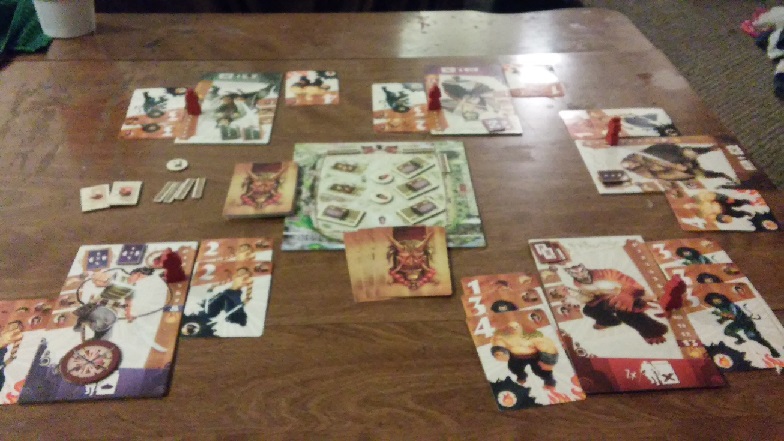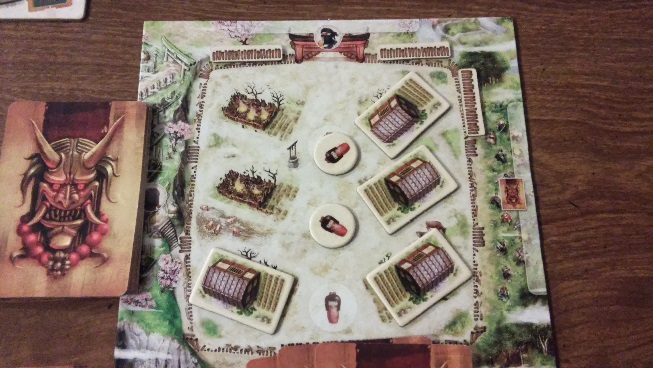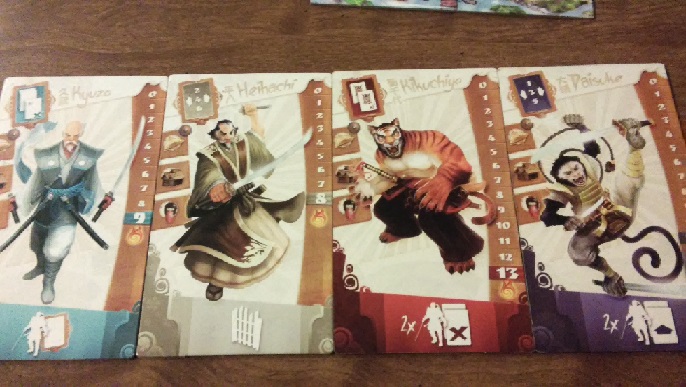SAMURAI SPIRIT

|
| Funforge Rules Read Comments |
| Players: 1 - 7 |
| Playing Time: 30 Minutes |
A review by Scott Fish
Samurai Spirit is the latest game by Antoine Bauza, the creator of such fantastic games as 7 Wonders, Hanabi, Takenoko, Tokaido, and Ghost Stories. It is a 1-7 player cooperative game which puts seven brave samurai against a seemingly endless horde of bandits in order to defend a small village of farmers.
If that plot sounds familiar, then I applaud your taste in movies; the theme of the game is very much influenced by the 1956 classic Shichinin no Samurai (Seven Samurai) by Akira Kurosawa (Or for you western movie buffs, the 1960 Americanized remake, The Magnificent Seven). Mr. Bauza went so far as to write an homage to the movie in the rule book and named all of the Samurai in the game after the Samurai in the film.
A full game of seven players should take about 45 minutes, but a 2–3 player game can be done as quickly as 20 minutes. There is also a solo variant where one person controls two samurai with a few tweaks to the rules.
Recommended for: Groups of 4-7 players who are looking for a quick, light cooperative game, people who enjoy the "Seven Samurai" theme, people who do not mind losing often to forces out of their control (like in traditional solitaire, Chainsaw Warrior, or DungeonQuest).
GAMEPLAY

A typical setup for Samurai Spirit
Gameplay is very easy to grasp. You start the game with a deck of cards with values ranging from 1–4. The number of cards will always be the number of players * 7. This is the raider deck. On your turn you must first take any negative effects generated by the last raider card you confronted. You then have three options:
- Draw a card from the raider deck and fight it. You fight raiders either by confronting (putting it on the right side of your board)
or defending (left side of your board).
- If you choose to confront, you place the card overlapping the previous card (if any), but still leave the number visible. You then move your meeple down the combat line to match the sum of all your confronted cards. If you go over your maximum value, you are knocked out and must pass next round. You will also lose one fortification. If you hit your number exactly, you activate your Kiai superpower (more on that later)!
- If the raider has an icon which matches one on the left side of your board, you can choose to defend and place the card on the left side of the board. You won't get the battle penalty or have to move your meeple further down the battle line, but you can only defend once per round per symbol; once all three symbols have been used, you can't defend for the rest of the round.
- Give your support token to another player; this will allow the player to use your unique ability for the next turn only. You then place the top card of the raider deck in the intruder pile to be resolved at the end of the round.
- Pass. If you pass you are out for the rest of the round and will not be affected by any game effects until the next round.
Each player takes turns doing this until either everyone passes or the raider deck is empty. If everyone passed and there are still raider cards left, they all move to the intruder pile (they got past your defenses and are now terrorizing the village!) Now the players check to see if they have any missing spot on the defense side of their board; for every missing spot you may have to get wounded, lose a farm, or lose a villager. Then each villager still alive will reward the team with a bonus of some kind. Finally, the intruder stack is turned face up; for every raider with fire at the bottom of the card you must lose one barricade (or farm, if you are out of barricades).
For round two, you gather up all the played cards and must shuffle in as many lieutenants (five value cards) as there are players. In round three you do the same thing for the boss cards (six value cards).
Every Samurai has a unique ability you can use once every turn; some will allow you to pass cards to your neighbors, some will allow you to ignore the negative effects of certain cards, and so on. Every Samurai also has a unique Kiai power, which is activated when your meeple is moved onto (but not past) the last number on your battle line. Kiai powers can mend fences, heal players, discard cards, and rearrange player’s battle lines. In addition, you will be able to discard your topmost bandit from your battle line, allowing you to fight on in future turns. It is almost always worth it to activate someone’s Kiai power if at all possible.
Every Samurai board has two sides; a human form and an animal form. Your animal form will have a longer battle line and a stronger Kiai power than your human side. Each Samurai essentially has four health; every time a game effect instructs you to take a wound you must do the following in order:
- No wound marker and you are still in human form: gain one wound marker.
- Wound marker and still in human form: flip your card over to the animal form and discard the wound token. All of the cards you fought so far in the round remain in their original positions.
- No wound marker and you are in animal form: gain one wound marker.
- Wound marker and in animal form: You have died and your team loses the game.
If you reach the end of the third round without losing all of the farms or villagers and all of the Samurai survive, you win!
COMPONENTS
No complaints here; the main board, player boards, and tokens are all made from sturdy cardstock and won't bend from repeated use. The cards feel like standard playing cards and have held up well after 20ish plays of shuffling. These cards do not need plastic sleeves unless you are adamant about protecting your games. The wooden meeples are shaped like Samurai which is a nice touch.

This is the Village game board.
The two best parts about the components are the artwork and the "footprint" of the game. The artwork is simply gorgeous; each Samurai board is unique and rich in its own way, the card values each have their own grisly looking raider on them, and the main board is wonderfully detailed; a feast for the eyes.

These are four of the seven possible Samurai game boards.
What do I mean by a game's footprint? In short, how much space it takes up on my shelf. This game could have easily been put into a box twice its size; a trend I'm seeing more and more often (I'm looking at you, Splendor). This creates a burden for board game junkies like me who already have storage space issues. This game box and insert were intelligently designed to fit everything securely into the minimum space needed. It's little touches like this that we addicts really appreciate.
PRICE
This game retails for about $30, and I have played it several dozen times. Having such a short play time and having a solo variant dramatically increased the replay value, but I foresee my time with this game shrinking to almost zero in the future. More on why this game's days are numbered in the next section.
GENERAL IMPRESSIONS
Enjoyment is where the game truly suffers, and it's due to three big concerns: lack of strategic options, wild swings of luck, and poor scalability.
During your turn you usually have two main choices to make (Do I fight or support? If I fight which side of the board do I use?) which can be further restricted by the negative effects imposed by the raiders you are confronting. You almost never voluntarily choose to pass on your turn, and you rarely want to assist because you are increasing the odds of burning the whole village down (about half of the raider cards have the fire symbol). This makes the game get same-y very quickly. You can form a loose strategy by taking stock of what cards were revealed in the first round and anticipating what will come out in future rounds since the same deck is used three times with some cards added in each round. This can help ensure people fill in the defense side of the board by noticing if one symbol shows up less than the others (Hey, there only six hat symbols in this deck, you better defend one the first chance you get!). But this card counting does nothing for you the first round, and does little to mitigate the serious luck swings.
This game is brutally tough thanks in large part to the lack of control you have in what you face each turn. Only some of the Samurai have the ability to pass cards to other players, and the ones who cannot will sooner or later draw that one card that they cannot mitigate. There is no way for other players to interact with you during your turn, so you may just be stuck with a bad card and no good options. There's no mechanic in the game which allows you to prepare for that inevitable game changing card: the support action is only good for the very next turn and you have to use it or lose it regardless if you actually needed it that turn.
The third problem I ran into was scalability; this game is borderline unplayable for one or two players. My first two player game only had one villager icon in the deck of 14 cards, so one of us were automatically losing one villager each round. Since there are only three villagers, this was an auto lose situation, and we could do nothing about it. I find it very hard to believe this situation never came up in playtesting which makes me believe this game was rushed out the door without enough focus on gameplay. As the number of players increases, so does the playability: you have more options to use your support actions and deciding whom sits next to whom to maximize combos, but the quantity of raider cards also increases, so you still run into the problem of not having enough options to control the bad swings of luck.
So why on Earth would I play a game I didn't like over 20 times? Because I kept telling myself there was more to this game than just hitting Blackjack with each Samurai. This game has a lot in common with its older brother, Ghost Stories; another game famed for its brutally hard gameplay and swings of luck. Ghost Stories has a layer of tactical strategy which is not immediately obvious the first few plays. Once you see how your place on the board will effect your future turns, the game changes from a random luckfest to a challenging, but rewarding experience. It took me several plays to see this in Ghost Stories, so I felt I owed Samurai Spirit the same courtesy. I can safely say, that after playing at all difficulty levels of the game and with all different number of players, that the choices you have available to you are just not enough to overcome the luck factor on a consistent basis. There will be sessions where you will play optimally (even if you had perfect information and knew what was coming in the deck) and you will still lose due to a bad card combo.
I will freely admit that maybe this is a game that takes hundreds of games instead of dozens to see the strategy options, but if you want me to invest in that many sessions, you better have a very good hook to keep me interested. A pretty board and a cool theme only lasts so long; sooner or later I need several interesting and challenging decisions to make. This game does not have that.
That being said, it is still a very fast game (especially considering it can handle seven players), and the theme does a good job of sucking you into the conflict. The characters are varied enough to try different approaches to the game. If you like the idea of a medieval tower defense game and don't mind randomly losing, this game might be for you.
Out of all the Bauza games I have played, this is by far the weakest, least play-tested entry. The game mechanics seem half baked and rushed; I would have enjoyed a few more ways of dealing with the raiders, even if that meant each bandit wouldbe more difficult. This game suffers more because of Mr. Bauza's previous successes; we know what he is capable of but this entry is made even more unpalatable when compared to 7 Wonders or Takenoko.
I can only recommend this game for people who really enjoy the Samurai theme and are looking for a light, quick, coop experience. And you lost your copy of Hanabi.
Final Score: 2/5
Very pretty and thematic enough, but about as deep as a kiddie pool. You can easily get $30 of fun out of this game, but you will hit a point where you will never want to play it again out of sheer frustration.
BIO
Hi, I'm Scott Fish! I have been an avid board game player / collector for about five years. My favorite games include Power Grid, BattleCON, X-wing, Warmachine, and Galaxy Defenders. I spend most of my free time either playing games with various gaming groups in the Omaha metro, learning new games, or playing soloable games at home.

Comments
Good and accurate review, but I still like it
While I don't disagree with the main points in Scott's review, I would give it a higher rating (3 out of 5 = I like it). There's that feeling that if I only made the right decision at one step that we could have saved the town. Since it's a short game, I don't mind playing it over and over, and Bauza has hinted that there is a deeper strategy hidden within. I don't know if it's this challenge that keeps me wanting to come back again or just wanting to actually win a full game in different scenarios (eg. different numbers of players). (Not so different from Ghost Stories, which I love.) Or it's just that I haven't played it 30 times like Scott has. :-)
2P rules
The rulebook states that when playing 2P, you have to check the plunderer deck before the game starts to make sure you have at least two doll icons.
RE: 2p rules
The version I played was from the first printing from Gen Con; I pointed out my 2p concerns on the BGG forums back in August and the rules have since been updated. The rulebook I received did not mention anything about checking the plunderer deck. My point was that it was an obvious flaw and should have been caught in playtesting.